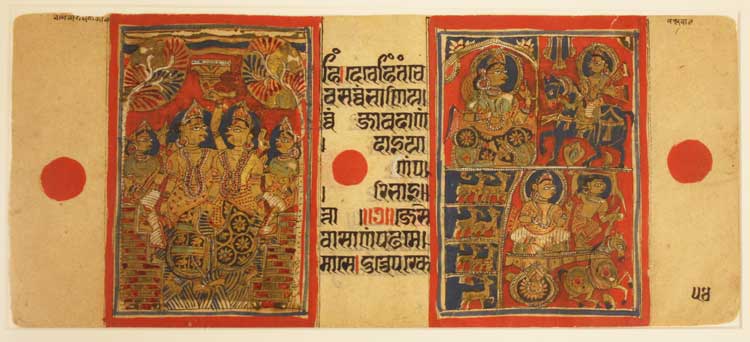Manuscript Page from Kalpasutra

Jain Book of Rituals (Svetambaras)
Opaque watercolour and gold on paper
Western India
Early 16th century
4 3/8 x 10 1/4 inches
Two images are shown on this page that concern Arishtanemi (Neminatha), the 22nd Jina, by legend a cousin of Krishna.
In the first, Krishna and his wives encourage Nemi to marry. The image shows a bathing ghat with two men standing on steps that lead down to the water. Krishna, on the right, raises his right hand with an object that looks like a horn. Behind each man are Krishna's wives, who each hold a vessel containing milk. The picture combines the urging of the wives and of Krishna. Nemi consents to marry, even though he mentions that there is no profit in associating with women and marrying. He prefers to strive for perfection and end the cycle of rebirth.
In the image on the right, in the upper register Arishtanemi rides to meet his bride-to-be, Rajimati, who is holding a mirror and waiting for the groom. Below, Arishtanemi sees the terrified animals in their pen awaiting slaughter for the wedding feast and decides he cannot go through with it. He turns his chariot around and leaves to renounce the world.
The Kalpasutra (Book of Rituals) is the most important canonical text in Jain literature for the Svetambaras (white-clad), one of the two sects of Jainism. Jainism is one of the oldest religions to have survived until the present time, and its basic teaching is one of non-violence. The Kalpasutra is divided into three sections. The first section deals with the lives of the twenty-four Jinas or Tirthankaras, who were the Jain spiritual teachers or 'ford-makers'. The second part deals with the life of Mahavira, the twenty-fourth Tirthankara. The third part deals with rules for the ascetics and laws during the four months (chaturmas) of the rainy season, when ascetics temporarily abandon their wandering life and settle down amidst the laity. This is the time when the festival of Paryushan is celebrated and the Kalpasutra is traditionally recited.
About Us | Contact Us
©2012 Graduate Theological Union Library